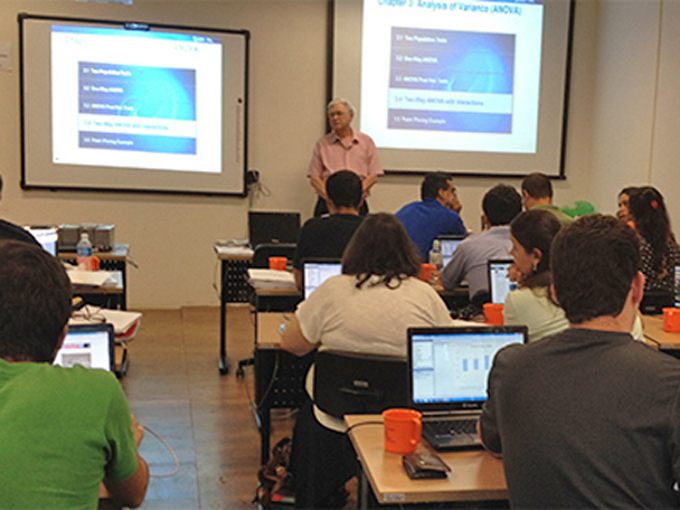Representative presented SAS, a leading business intelligence and analytical application company
Between December 9th and 11th, the Mathematics, Statistics and Chemistry Department (LCE) of Luiz de Queiroz College of Agriculture (USP/ESALQ) offered the Introduction to Mixed Models Training Course. The course featured SAS applications developed by a leading enterprise in business intelligence and analytic applications. At the time, undergraduate and graduate students, researchers and professionals had the opportunity to improve their skills, becoming able to apply the SAS Enterprise Guide to analyze linear mixed models using PROC MIXED. SAS is an integrated system of applications for data analysis, and SAS solutions are used by a number of industries worldwide.
According to the lecturer Michael Speed, professor of statistics at Texas A&M University, the SAS system has been used in agriculture since it was developed in 1976 by statisticians from agriculture colleges in the US. “For this reason, we have been developing specialized software for the analysis of agricultural experiments up to the present date”. Speed was invited to ESALQ by Professor Carlos Tadeu Dias dos Santos, head of the LCE, to present the mixed models, including fixed effects, such as different types of fertilizers. “We do not want to draw conclusions restricted to the environment where the experiment is being conducted, as it is necessary to understand the applicability of the studied object within the whole country. Thus, we need to consider the existence of random effects, and our models allow this understanding, enabling extrapolation from local experiments to broader levels,” said Speed.
According to Santos, this activity is mainly directed to researchers from the Agricultural Statistics and Experimentation graduate program, but this tool serves interests in several areas. “This course brings themes of great importance to students involved in modeling studies that apply mixed models, a technique widely used in recent years. Our graduate and post-doctoral students are being benefited with the knowledge of this tool, which provides a fast and reliable analysis with high graphic quality”.
Doctoral student Mirian Fernandes Carvalho Araujo is still in early development of her project, but her proposal will consider the use of mixed models. “Once I define my study object, my analysis will focus on fixed and random effects, and because we work with both aspects it is increasingly difficult to obtain reliable conclusions. This feature is going to facilitate my future analysis”.
F. Michael Speed, Ph.D., is currently a professor of statistics at Texas A&M University. He holds a Ph.D. in Statistics from Texas A&M and a master's degree in Mathematics from St. Mary's University of San Antonio. Currently, Dr. Speed is also the Associate Dean of Technology Mediated Instruction in the College of Science at Texas A&M. He received the College AFS Teaching Award in 2001, as well as the H.O. Hartley Award in 1999. Dr. Speed has also refereed papers for Technometrics, American Statistician, and Journal of the American Statistical Society. He has also served as the associate editor of Communications in Statistics. His current research interests include analyzing harvest data and fresh water inflows in Galveston Bay as well as designing low cost experiments for analyzing exhaust emission data (Source: http://support.sas.com/).
Written by: Caio Albuquerque
Translated by: Débora Andrade Pereira
Proofread by: Marisa Aparecida B. Regitano d'Arce
Photo: Caio Albuquerque
Acom (ESALQ’s Office of Communications)
December 10th, 2013


